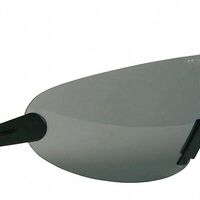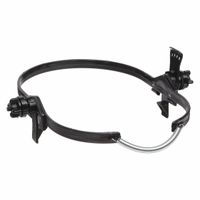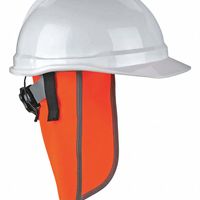Call +(254) 703 030 000 / 751 483 999 / 721 704 777
- Home
- Safety
- Head Protection
- Head Protection Accessories
.....Read More
Frequently Asked Questions
What are the benefits of using head protection accessories?
Head protection accessories, such as helmets and hard hats, offer numerous benefits across various environments and activities. Primarily, they provide critical protection against head injuries, which can be life-threatening or lead to long-term disabilities. In construction, manufacturing, and other industrial settings, hard hats shield workers from falling objects, debris, and accidental impacts, significantly reducing the risk of traumatic brain injuries.
In sports, helmets are essential for safeguarding athletes from concussions and other head-related injuries. For example, in cycling, motorcycling, and contact sports like football, helmets absorb and distribute the force of impacts, minimizing the potential for skull fractures and brain trauma.
Head protection also enhances visibility and safety. Many helmets and hard hats come with reflective materials or bright colors, making wearers more visible in low-light conditions or busy environments, thereby reducing the risk of accidents.
Moreover, head protection accessories can be equipped with additional features to improve functionality and comfort. For instance, some helmets include visors or face shields to protect against UV rays, dust, and flying particles. Ventilation systems in helmets help regulate temperature, ensuring comfort during prolonged use.
In hazardous work environments, head protection can be integrated with communication devices, ear protection, or respiratory systems, providing comprehensive safety solutions. This integration is crucial for maintaining effective communication and protection in noisy or contaminated settings.
Overall, the use of head protection accessories is a proactive measure that not only ensures personal safety but also promotes a culture of safety awareness and compliance with occupational health and safety regulations. This, in turn, can lead to reduced workplace accidents, lower healthcare costs, and improved productivity.
How do sun shades and visors enhance safety helmets?
Sun shades and visors enhance safety helmets by providing several key benefits that contribute to both safety and comfort for the wearer. Firstly, they offer protection against the sun's harmful ultraviolet (UV) rays, which can cause skin damage and increase the risk of skin cancer. By blocking or filtering these rays, visors help protect the face and eyes, reducing glare and improving visibility in bright conditions.
Secondly, visors act as a shield against environmental elements such as wind, dust, rain, and debris. This protection is crucial for maintaining clear vision and preventing eye injuries, especially in high-speed activities like motorcycling or cycling. By keeping these elements at bay, visors help the wearer maintain focus and concentration, reducing the likelihood of accidents.
Additionally, sun shades and visors can enhance comfort by reducing eye strain and fatigue. In bright sunlight, the eyes can become strained from squinting, leading to discomfort and distraction. A visor helps mitigate this by providing shade and reducing the intensity of light entering the eyes, allowing for a more relaxed and comfortable experience.
Furthermore, visors can be designed with anti-fog and anti-scratch coatings, ensuring clear vision in various weather conditions and prolonging the lifespan of the helmet. Some visors are also tinted or polarized, offering additional glare reduction and improved contrast, which can be particularly beneficial in environments with variable lighting conditions.
Overall, sun shades and visors are integral components of safety helmets, enhancing protection, comfort, and visibility, thereby contributing to the overall safety and effectiveness of the helmet in various activities and environments.
What is the purpose of chin straps on helmets?
The purpose of chin straps on helmets is to ensure the helmet remains securely in place on the wearer's head, providing consistent protection during activities that pose a risk of head injury. Chin straps are crucial for maintaining the helmet's position, especially during sudden movements, impacts, or falls. They prevent the helmet from shifting, sliding, or being dislodged, which could expose the head to injury.
Chin straps are designed to be adjustable, allowing for a snug fit that accommodates different head sizes and shapes. This adjustability ensures that the helmet can be worn comfortably while still providing maximum protection. The strap typically includes a buckle or fastener that allows for easy fastening and unfastening, ensuring that the helmet can be quickly removed in case of an emergency.
In sports like cycling, football, and hockey, where high-speed impacts are common, chin straps are essential for safety. In motorcycling, they are critical for keeping the helmet in place at high speeds and during potential crashes. In construction and industrial settings, chin straps help keep helmets secure when workers are moving or working at heights, reducing the risk of injury from falling objects or falls.
Overall, chin straps are a vital component of helmet design, enhancing the protective function of helmets by ensuring they remain in the correct position to absorb and distribute impact forces effectively.
How do hard hat covers improve safety?
Hard hat covers enhance safety by providing additional protection and functionality to standard hard hats. They offer an extra layer of defense against environmental elements such as rain, sun, and cold, which can affect a worker's comfort and focus. By shielding against UV rays, hard hat covers help prevent sunburn and reduce the risk of heat-related illnesses, ensuring that workers remain alert and effective.
In cold environments, insulated hard hat covers help retain heat, preventing conditions like hypothermia and frostbite. This thermal protection is crucial for maintaining body temperature and ensuring that workers can perform their tasks without the distraction of extreme cold.
Hard hat covers also improve visibility, which is a critical safety feature in low-light or high-traffic areas. Many covers come in high-visibility colors or with reflective strips, making it easier for workers to be seen by others, thereby reducing the risk of accidents.
Additionally, hard hat covers can protect the hard hat itself from wear and tear, extending its lifespan and ensuring it remains effective in protecting against impacts. They can also be customized with company logos or safety messages, promoting a culture of safety and team identity.
Overall, hard hat covers contribute to a safer working environment by enhancing the protective capabilities of hard hats, improving worker comfort, and increasing visibility, all of which are essential for preventing accidents and injuries on the job site.
What types of head protection accessories are available for sun protection?
Various head protection accessories are available for sun protection, each designed to shield the face, neck, and head from harmful UV rays. Here are some common types:
1. **Wide-Brimmed Hats**: These hats, such as sun hats or floppy hats, have brims that extend all around, providing shade to the face, ears, and neck. They are often made from materials like straw, cotton, or synthetic fibers with UV protection.
2. **Baseball Caps**: While they primarily protect the face, they can be paired with neck flaps or sun shields for additional coverage. Some caps are made with UV-protective fabrics.
3. **Bucket Hats**: Featuring a downward-sloping brim, bucket hats offer moderate sun protection for the face and neck. They are typically made from lightweight, breathable materials.
4. **Visors**: These provide shade to the face while leaving the top of the head exposed. They are ideal for those who want ventilation but should be used with sunscreen on exposed areas.
5. **Legionnaire Hats**: These have a flap at the back to protect the neck, in addition to a front brim. They are popular for outdoor activities and are often made from UV-protective materials.
6. **Sun Helmets**: Also known as pith helmets, these are rigid hats that provide full coverage and are often used in extremely sunny environments.
7. **Bandanas and Scarves**: These can be wrapped around the head and neck for versatile sun protection. They are often made from lightweight, breathable fabrics.
8. **Neck Gaiters**: These tube-shaped garments can be pulled up over the neck and lower face, offering protection from the sun and dust.
9. **UV-Protective Headbands**: These are designed to cover the forehead and can be worn under other hats for additional protection.
Each accessory offers varying levels of protection and comfort, making it important to choose based on personal needs and activity levels.
How do bump caps differ from hard hats?
Bump caps and hard hats are both types of head protection used in various work environments, but they serve different purposes and offer different levels of protection.
Bump caps are designed to protect against minor bumps, scrapes, and head injuries in environments where there is a risk of hitting the head against stationary objects. They are typically made from lightweight materials like plastic or fabric and often resemble a baseball cap with a protective insert. Bump caps are comfortable, breathable, and suitable for indoor use or areas with limited overhead hazards. They are not designed to protect against falling objects or heavy impacts.
Hard hats, on the other hand, are designed to provide protection against more severe hazards, such as falling objects, electrical shocks, and impacts. They are made from durable materials like high-density polyethylene (HDPE) or fiberglass and feature a suspension system inside the shell to absorb and distribute the force of an impact. Hard hats are required in construction sites, industrial settings, and other environments where there is a significant risk of head injuries from falling or flying objects. They often come with additional features like chin straps, visors, and earmuffs for enhanced protection.
In summary, bump caps are suitable for low-risk environments where the primary concern is minor head injuries from stationary objects, while hard hats are essential for high-risk environments with potential for serious head injuries from falling objects or other hazards.
What materials are commonly used in head protection accessories?
Head protection accessories, such as helmets and hard hats, are designed to safeguard the head from injuries. Common materials used in their construction include:
1. **Polycarbonate**: Known for its high impact resistance and lightweight properties, polycarbonate is often used in sports helmets and face shields.
2. **ABS (Acrylonitrile Butadiene Styrene)**: This thermoplastic is durable, impact-resistant, and lightweight, making it a popular choice for hard hats and some types of helmets.
3. **Fiberglass**: Used in high-performance helmets, fiberglass is strong and can withstand significant impact. It is often layered with other materials for added protection.
4. **Kevlar**: Known for its high tensile strength-to-weight ratio, Kevlar is used in military and motorcycle helmets for its ability to absorb and disperse energy.
5. **EPS (Expanded Polystyrene)**: Commonly used in bicycle helmets, EPS foam is lightweight and provides excellent shock absorption by compressing upon impact.
6. **EPP (Expanded Polypropylene)**: Similar to EPS but more durable, EPP can withstand multiple impacts, making it suitable for helmets used in activities with repeated falls.
7. **Carbon Fiber**: Used in high-end helmets, carbon fiber is extremely strong and lightweight, offering excellent protection and comfort.
8. **Nylon and Polyester**: These materials are often used for the inner lining and straps of helmets, providing comfort and moisture-wicking properties.
9. **Leather**: Used in vintage-style helmets and for aesthetic purposes, leather offers some abrasion resistance but is not typically used for impact protection.
These materials are often combined to optimize protection, comfort, and durability, tailored to the specific needs of the activity or industry.








